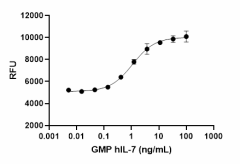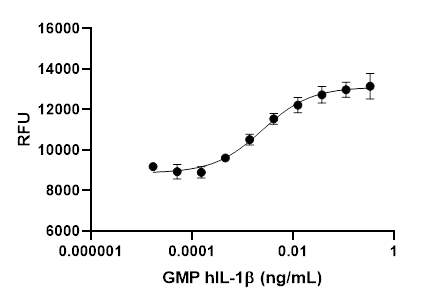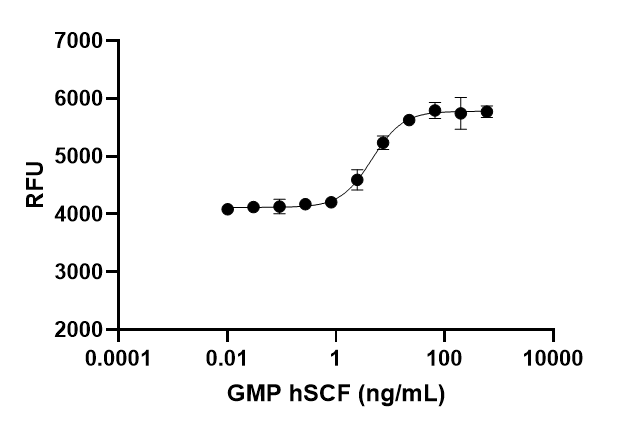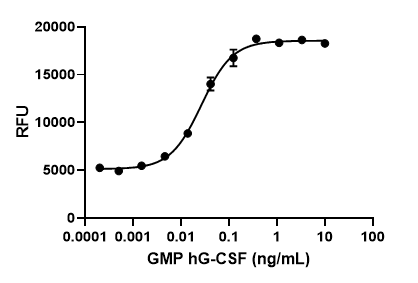- Other Names
- Interleukin 7, Lymphopoietin-1 (LP-1), IL7
- Ave. Rating
- Submit a Review
- Product Citations
- publications

-

GMP recombinant human IL-7 induces proliferation of PHA-activated human peripheral blood lymphocytes (PBL) in a dose-dependent manner with an ED50 range of 0.2 - 1.2 ng/mL.
| Cat # | Size | Price | Quantity Check Availability | Save | ||
|---|---|---|---|---|---|---|
| 581914 | 25 µg | 704€ | ||||
| 581916 | 100 µg | 2156€ | ||||
IL-7 was initially described as a stromal derived factor which is capable of inducing the growth of pre-B cells in vitro. IL-7 acts on a variety of cells through its receptor (IL-7R), a heterodimer consisting of IL-7Rα (CD127) and a common γ chain (CD132, γc) shared by other cytokine (IL-2, IL-4, IL-9, IL-15, and IL-21) receptors. In addition, IL-7Rα is shared with TSLP. The generation of IL-7-deficient and IL-7Rα-deficient mice and monoclonal antibody blocking experiments confirmed the requirement of IL-7 for B-cell development in mice. Nevertheless, mutations in the α chain of the IL-7 receptor in patients with severe combined immunodeficiency (SCID) confirmed that IL-7 is indispensable for T-cell development in humans. However, the presence of B cells in these individuals suggests important differences between the role of IL-7 in murine and human lymphocyte development. Thus, although human B-cell development does not appear to require IL-7, immature human B cells do proliferate in response to IL-7. Nevertheless, most recent information suggests that IL-7 dependence in human lymphopoiesis increases during the progression of ontogeny in cord blood and bone marrow. IL-7 can be associated to hepatocyte growth factor (HGFβ) to form a hybrid cytokine (IL-7/HGFβ), which induces greater proliferation of CFU-S, SLPs, and pre–pro-B cells than does native IL-7. The hybrid cytokine signals through both IL-7R (IL-7Rα plus γc) and c-Met. IL-7 has a thymic antiapoptotic effect and induces the expression of antiapoptotic proteins Bcl-2 and Mcl-1 and the inhibition of proapoptotic proteins Bax and Bad. In addition, IL-7 is a key regulator of glucose uptake in T lymphocytes. TGF-β has been shown to down-regulate IL-7 mRNA and protein secretion from human bone marrow stromal cells. In addition, TGF-β inhibits IL-7-induced proliferation of pre-B cells.
Product DetailsBioLegend Cell-Vive™ GMP Recombinant proteins are manufactured and tested in accordance with USP Chapter 1043, Ancillary Materials for Cell, Gene and Tissue-Engineered Products and Ph. Eur. Chapter 5.2.12 in a dedicated GMP facility compliant with ISO 13485:2016. Specifications and processes include:
- Low endotoxin level (≤0.1 EU/μg)
- Purity (≥ 95% or higher)
- Bioburden testing
- Mycoplasma testing
- Batch-to-batch consistency
- Vendor qualification
- Raw material traceability and documentation
- Documented procedures and employee training
- Equipment maintenance and monitoring records
- Lot-specific certificates of analysis
- Quality audits per ISO 13485:2016
- QA review of released products
Product Details
- Source
- Human IL-7, amino acids Asp26-His177 (Accession # NP_000871.1) was expressed in 293E cells.
- Molecular Mass
- The 165 amino acid recombinant protein has a predicted molecular mass of approximately 18.8 kD. The DTT-reduced and non-reduced protein migrate at approximately 20 - 30 kD by SDS-PAGE. The C-terminal contains an 8His-(TG8HGGQ)-tag.
-
N-terminal
Sequence Analysis - Asp-(Cys)-Asp-Ile-Glu-Gly-Lys-Asp-Gly-Lys
- Purity
- ≥ 95%, as determined by Coomassie stained SDS-PAGE
- Formulation
- 0.1 µm filtered protein solution is in PBS, pH 7.2.
- Endotoxin Level
- Less than or equal to 0.1 EU per μg protein as determined by the LAL method
- Residual Host Cell Protein Content
- ≤ 0.500 ng/µg by ELISA
- Concentration
- 500 µg/mL
- Storage & Handling
- Unopened vial can be stored between 2°C and 8°C for up to 2 weeks, at -20°C for up to six months, or at -70°C or colder until the expiration date. For maximum results, quick spin vial prior to opening. The protein can be aliquoted and stored at -20°C or colder. Stock solutions can also be prepared at 50 - 100 µg/mL in appropriate sterile buffer, carrier protein such as 0.2 - 1% endotoxin-free BSA or HSA can be added when preparing the stock solution. Aliquots can be stored between 2°C and 8°C for up to one week or stored at -20°C or colder for up to 3 months. Avoid repeated freeze/thaw cycles.
- Activity
- ED50 = 0.2 – 1.2 ng/mL, as determined by a dose-dependent stimulation in a proliferation assay with PHA-activated human peripheral blood lymphocytes (PBL). Deep Blue Cell Viability™ Kit (Cat. No. 424701) is used to measure the proliferation. The specific activity of Cell-Vive™ GMP Recombinant Human IL-7 (carrier-free) is >1 x 108 IU/mg when compared against the WHO International Standard for Human IL-7 (NIBSC code: 90/530).
- Application
-
Bioassay
Cell Culture - Application Notes
-
BioLegend carrier-free recombinant proteins provided in liquid format are shipped on blue ice. Our comparison testing data indicates that when handled and stored as recommended, the liquid format has equal or better stability and shelf-life compared to commercially available lyophilized proteins after reconstitution. Our liquid proteins are verified in-house to maintain activity after shipping on blue ice and are backed by our 100% satisfaction guarantee. If you have any concerns, contact us at tech@biolegend.com.
- Disclaimer
-
BioLegend Cell-Vive™ GMP Recombinant proteins are for research use only. Suitable for ex vivo cell processing. Not for injection or diagnostic or therapeutic use. Not for resale. BioLegend will not be held responsible for patent infringement or other violations that may occur with the use of our products.
Antigen Details
- Distribution
-
IL-7 is produced by epithelial cells in thymus, bone marrow, and intestine. Additional sites of IL-7 production include epithelial goblet cells, keratinocytes, fetal liver, adult liver, dendritic cells, skeletal muscle cells, fibroblastic reticular cells, and follicular dendritic cells.
- Function
- IL-7 induces proliferation of human immature B cells, and it is critical for T-cell development and peripheral T-cell homeostasis. Regulates T folicular helper cells.
- Interaction
- B cells, Hematopoietic stem and progenitors
- Ligand/Receptor
- IL-7Rα (CD127), common gamma chain (γc or CD132)
- Bioactivity
- Measured by its ability to induce proliferation of 7TD1 cell
- Cell Type
- B cells, Dendritic cells, Epithelial cells, Leukemia, Lymphocytes, NK cells, T cells, Tfh, Thymocytes
- Biology Area
- Cell Biology, Cell Proliferation and Viability, Immuno-Oncology, Immunology, Stem Cells
- Molecular Family
- Cytokine/Chemokine Receptors, Cytokines/Chemokines
- Antigen References
-
- Park LS, et al. 1990. J. Exp. Med. 171:1073.
- Fry TJ and Mackall CL. 2002. Blood 99:3892.
- Lai L, et al. 2006. Blood 107:1776.
- Link A, et al. 2007. Nat. Immunol. 8:1255.
- Wofford J, et al. 2008. Blood 111:2101.
- Parrish YK, et al. 2009. J. Immunol. 182:4255.
- Saini M, et al. 2009. Blood 113:5793.
- Guimond M, et al. 2009. Nat. Immunol. 10:149.
- Gene ID
- 3574 View all products for this Gene ID
- UniProt
- View information about IL-7 on UniProt.org
 Login / Register
Login / Register 



















Follow Us